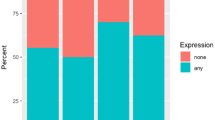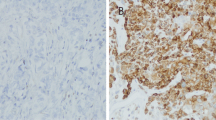Abstract
Triple negative breast cancer (TNBC) is immunohistochemically characterised by the lack of expression of the estrogen receptor (ER), progesterone receptor (PR), and human epidermal growth factor receptor type 2 (HER2). TNBC is known for its poor prognosis and high recurrence probability. There is no effective targeted treatment for TNBC, but only adjuvant chemotherapies. There are two TNBC subtypes, basal-like and non-basal-like, which are defined based on positive cytokeratin (CK) 5/6 and/or epidermal growth factor receptor (EGFR) expression. In particular, CK5/6 expression is reported to correlate with TNBC recurrence. TNBC lacks ER-α expression, but some TNBCs are known to express the androgen receptor (AR). Moreover, although p53 accumulation is detected in various malignant tumors, its influence on adjuvant chemotherapy for patients with TNBC remains unclear. The aim of this study was to assess the combined immunohistochemical expression of CK 5/6, AR, and p53 as a potential prognostic marker of adjuvant chemotherapy for patients with TNBC. The expression of CK5/6, AR, and p53 in formalin-fixed and paraffin-embedded (FFPE) surgical sections from 52 patients with TNBC was analysed by immunohistochemistry (IHC) and the co-expression patterns in individual cells were investigated by immunofluorescent (IF) staining. Low AR expression was correlated with high clinical stage (P < 0.05) and low nuclear grade (P < 0.05). The expression of CK5/6 and p53 did not correlate with clinicopathological features. Patients who needed adjuvant chemotherapy presented the worst prognosis. In particular, when the IHC expression pattern was CK5/6 (−), AR (−), and p53 (+), the disease free survival (DFS) and overall survival (OS) were the worst. On the other hand, patients with AR (+) and p53 (−) TNBC presented a good prognosis. The analysis of the co-expression status of these three markers showed that no cells presented both AR and CK5/6 expression. Furthermore, TP53 mRNA expression was higher in patients with AR-negative TNBC (P < 0.05) and in patients with the worst prognosis (P < 0.05) than in the other patients. These results suggested that, in patients with CK5/6-negative TNBC, AR expression correlated with good prognosis, but p53 accumulation correlated with poor prognosis. The present IHC markers allowed us to predict the post-surgery prognosis of patients with TNBC. In conclusion, TNBCs are heterogeneous. Patients with the CK5/6 (−), AR (−), and p53 (+) TNBC subtype, evaluated by IHC, presented the worst prognosis. These IHC markers will be helpful to follow patients with TNBC.




Similar content being viewed by others
References
Perou CM, Sørlie T, Eisen MB, van de Rijn M, Jeffrey SS, Rees CA, Pollack JR, Ross DT, Johnsen H, Akslen LA, Fluge O, Pergamenschikov A, Williams C, Zhu SX, Lønning PE, Børresen-Dale AL, Brown PO, Botstein D (2000) Molecular portraits of human breast tumours. Nature 406:747–752
Sørlie T, Perou CM, Tibshirani R, Aas T, Geisler S, Johnsen H, Hastie T, Eisen MB, van de Rijn M, Jeffrey SS, Thorsen T, Quist H, Matese JC, Brown PO, Botstein D, Lønning PE, Børresen-Dale AL (2001) Gene expression patterns of breast carcinomas distinguish tumor subclasses with clinical implications. Proc Natl Acad Sci USA 98:10869–10874
Reis-Filho JS, Tutt AN (2008) Triple negative tumours: a critical review. Histopathology 52:108–118
Cuenca-López MD, Montero JC, Morales JC, Prat A, Pandiella A, Ocana A (2014) Phospho-kinase profile of triple negative breast cancer and androgen receptor signaling. BMC Cancer 14:302 (Epub ahead of print)
Dent R, Trudeau M, Pritchard KI, Hanna WM, Kahn HK, Sawka CA, Lickley LA, Rawlinson E, Sun P, Narod SA (2007) Triple-negative breast cancer; clinical features and patterns of recurrence. Clin Cancer Res 13:4429–4434
Lehmann BD, Bauer JA, Chen X, Sanders ME, Chakravarthy AB, Shyr Y, Pietenpol JA (2011) Identification of human triple-negative breast cancer subtypes and preclinical models for selection of targeted therapies. J Clin Invest 121:2750–2767
Rakha EA, El-Sayed ME, Green AR, Lee AH, Robertson JF, Ellis IO (2007) Prognostic markers in triple-negative breast cancer. Cancer 109:25–32
Siegel R, Ma J, Zou Z, Jemal A (2014) Cancer statistics, 2014. Cancer J Clin 64:9–29
Neve RM, Chin K, Fridlyand J, Yeh J, Baehner FL, Fevr T, Clark L, Bayani N, Coppe JP, Tong F, Speed T, Spellman PT, DeVries S, Lapuk A, Wang NJ, Kuo WL, Stilwell JL, Pinkel D, Albertson DG, Waldman FM, McCormick F, Dickson RB, Johnson MD, Lippman M, Ethier S, Gazdar A, Gray JW (2006) A collection of breast cancer cell lines for the study of functionally distinct cancer subtypes. Cancer Cell 10:515–527
Mrklić I, Pogorelić Z, Capkun V, Tomić S (2013) Expression of androgen receptors in triple negative breast carcinomas. Acta Histochem 115:344–348
McGhan LJ, McCullough AE, Protheroe CA, Dueck AC, Lee JJ, Nunez-Nateras R, Castle EP, Gray RJ, Wasif N, Goetz MP, Hawse JR, Henry TJ, Barrett MT, Cunliffe HE, Pockaj BA (2014) Androgen receptor-positive triple negative breast cancer: a unique breast cancer subtype. Ann Surg Oncol 21:361–367
Suzuki T, Miki Y, Takagi K, Hirakawa H, Moriya T, Ohuchi N, Sasano H (2010) Androgens in human breast carcinoma. Med Mol Morphol 43:75–81
Robinson JL, Macarthur S, Ross-Innes CS, Tilley WD, Neal DE, Mills IG, Carroll JS (2011) Androgen receptor driven transcription in molecular apocrine breast cancer is mediated by FoxA1. EMBO J 30:3019–3027
Cops EJ, Bianco-Miotto T, Moore NL, Clarke CL, Birrell SN, Butler LM, Tilley WD (2008) Antiproliferative actions of the synthetic androgen, mibolerone, in breast cancer cells are mediated by both androgen and progesterone receptors. J Steroid Biochem Mol Biol 110:236–243
Fioretti FM, Sita-Lumsden A, Bevan CL, Brooke GN (2014) Revising the role of the androgen receptor in breast cancer. J Mol Endocrinol 52:R257–R265
Hanley K, Wang J, Bourne P, Yang Q, Gao AC, Lyman G, Tang P (2008) Lack of expression of androgen receptor may play a critical role in transformation from in situ to invasive basal subtype of high-grade ductal carcinoma of the breast. Hum Pathol 39:386–392
Kimura K, Markowski M, Bowen C, Gelmann EP (2001) Androgen blocks apoptosis of hormone-dependent prostate cancer cells. Cancer Res 61:5611–5618
Conzen SD (2008) Minireview: nuclear receptors and breast cancer. Mol Endocrinol 22:2215–2228
Nahleh Z (2008) Androgen receptor as a target for the treatment of hormone receptor-negative breast cancer: an unchartered territory. Future Oncol 4(1):15–21
Pozzobon A, Schneider L, Brum IS (2012) Androgen-modulated p21 and p53 gene expression in human non-transformed epithelial prostatic cells in primary cultures. Int J Mol Med 30:967–973
Serafin AM, Akudugu JM, Bohm L (2002) Drug resistance in prostate cancer cell lines is influenced by androgen dependence and p53 status. Urol Res 30:289–294
Bertheau P, Espié M, Turpin E, Lehmann J, Plassa LF, Varna M, Janin A, de Thé H (2008) TP53 status and response to chemotherapy in breast cancer. Pathobiology 75:132–139
Bennett WP, Hollstein MC, Metcalf RA, Welsh JA, He A, Zhu SM, Kusters I, Resau JH, Trump BF, Lane DP, Harris CC (1992) p53 mutation and protein accumulation during multistage human esophageal carcinogenesis. Cancer Res 52:6092–6097
Kihana T, Tsuda H, Teshima S, Okada S, Matsuura S, Hirohashi S (1992) High incidence of p53 gene mutation in human ovarian cancer and its association with nuclear accumulation of p53 protein and tumor DNA aneuploidy. Jpn J Cancer Res 83:978–984
Soreid JA, Lea OA, Varhaug JE, Skarstein A, Kvinnsland S (1992) Androgen receptors in operable breast cancer: relation to other steroid hormone receptors, correlations to prognostic factors and predictive value for effect of adjuvant tamoxifen treatment. Eur J Surg Oncol 18:112–118
Nakanishi Y, Shimizu T, Tsujino I, Obana Y, Seki T, Fuchinoue F, Ohni S, Oinuma T, Kusumi Y, Yamada T, Takahashi N, Hashimoto S, Nemoto N (2013) Semi-nested real-time reverse transcription polymerase chain reaction methods for the successful quantitation of cytokeratin mRNA expression levels for the subtyping of non-small-cell lung carcinoma using paraffin-embedded and microdissected lung biopsy specimens. Acta Histochem Cytochem 46:85–96
Macabeo-Ong M, Ginzinger DG, Dekker N, McMillan A, Regezi JA, Wong DTW, Jordan RCK (2002) Effect of duration of fixation on quantitative reverse transcription polymerase chain reaction analysis. Mod Pathol 15:979–987
Inanc M, Ozkan M, Karaca H, Berk V, Bozkurt O, Duran AO, Ozaslan E, Akgun H, Tekelioglu F, Elmali F (2014) Cytokeratin 5/6, c-Met expressions, and PTEN loss prognostic indicators in triple-negative breast cancer. Med Oncol 31:801
Yemelyanova A, Vang R, Kshirsagar M, Lu D, Marks MA, IeM Shih, Kurman RJ (2011) Immunohistochemical staining patterns of p53 can serve as a surrogate marker for TP53 mutations in ovarian carcinoma: an immunohistochemical and nucleotide sequencing analysis. Mod Pathol 24:1248–1253
Cuenca-Lopez MD, Montero JC, Morales JC, Prat A, Pandiella A, Ocana A (2014) Phospho-kinase profile of triple negative breast cancer and androgen receptor signaling. BMC Cancer 14:302
Pintens S, Neven P, Drijkoningen M, Van Belle V, Moerman P, Christiaens MR, Smeets A, Wildiers H, Vanden Bempt I (2009) Triple negative breast cancer: a study from the point of view of basal CK5/6 and HER-1. J Clin Pathol 62:624–628
Kenny PA, Lee GY, Myers CA, Neve RM, Semeiks JR, Spellman PT, Lorenz K, Lee EH, Barcellos-Hoff MH, Petersen OW, Gray JW, Bissell MJ (2007) The morphologies of breast cancer cell lines in three-dimensional assays correlate with their profiles of gene expression. Mol Oncol 1:84–96
Tan J, Chen B, He L, Tang Y, Jiang Z, Yin G, Wang J, Jiang X (2012) Anacardic acid (6-pentadecylsalicylic acid) induces apoptosis of prostate cancer cells through inhibition of androgen receptor and activation of p53 signaling. Chin J Cancer Res 24:275–283
Pan X, Zhao J, Zhang WN, Li HY, Mu R, Zhou T, Zhang HY, Gong WL, Yu M, Man JH, Zhang PJ, Li AL, Zhang XM (2009) Induction of SOX4 by DNA damage is critical for p53 stabilization and function. Proc Natl Acad Sci USA 106:3788–3793
Author information
Authors and Affiliations
Corresponding author
Rights and permissions
About this article
Cite this article
Maeda, T., Nakanishi, Y., Hirotani, Y. et al. Immunohistochemical co-expression status of cytokeratin 5/6, androgen receptor, and p53 as prognostic factors of adjuvant chemotherapy for triple negative breast cancer. Med Mol Morphol 49, 11–21 (2016). https://doi.org/10.1007/s00795-015-0109-0
Received:
Accepted:
Published:
Issue Date:
DOI: https://doi.org/10.1007/s00795-015-0109-0




